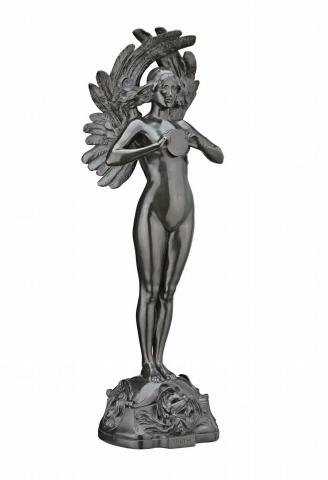TRUTH, 1894
Bertram Mackennal
bronze
60.5 cm height
signed at base: MACKENNAL
dated and inscribed at base: JUNE 12 - 1894 LONDON / TRUTH
Collection of the artist
Thence by descent
Pippin Drysdale, Perth
Sotheby's, Sydney, 22 April 2008, lot 57
Company collection, Melbourne
Bertram Mackennal: The Fifth Balnaves Sculpture Project, Art Gallery of New South Wales, Sydney, 17 August – 4 November 2007
Edwards, D., Bertram Mackennal: The Fifth Balnaves Foundation Sculpture Project, Art Gallery of New South Wales, Sydney, 2007, p. 37 (illus.), and catalogue raissoné in accompanying CD-ROM in accompanying CD-ROM
Truth, 1894, bronze, Art Gallery of New South Wales, Sydney
The human figure has had countless roles in art, its expressive potential being greater when depicted nude. Not only is it of supreme beauty in itself, it is also capable of undergoing the most subtle adaptations to express ideas lyrical or sublime, and quite the opposite. Frequently engaged as a metaphor, the female form, for example, has been painted and sculpted to represent everything from spring to justice, and evil to truth. In choosing the naked female figure for Truth 1894, Bertram Mackennal gave sculptural form to that idiomatic phrase 'the naked truth'. Figuring it as something without concealment, he was continuing a literary tradition that has long personified Truth as a naked woman. There is also the allied tradition summed up in John Keats' Ode on a Grecian Urn - 'Beauty is truth, truth beauty.' While Mackennal may have derived the pose from his sculpture Circe, the wings add an angelic or celestial touch, with the held mirror being a further extension of the idea of truth. It is said a mirror does not lie.
The sculptural exploration of truth as well as its application in life had special significance for Mackennal at this time. The reason was an unfortunate experience in Melbourne in 1891 during his time back in Australia. A competition was held for a major sculpture to adorn the front of Melbourne's Public Library, Museums and National Gallery. Mackennal entered a major work, the equestrian group The Triumph of Truth. It was awarded second prize, no first being given as the trustees considered that no entry was worthy of the commission. The public outcry was rightly loud, supported by Sarah Bernhardt, whom Mackennal had befriended during her then Australian tour. Back in London, he modelled Truth in 1894, having it cast in bronze in Paris in about 1897-98. In its combination of allegory, classicism, and poeticism, it is an elegant work justly contributing to Mackennal's international advancement through such feminine figures and stylish portraits of women.
DAVID THOMAS
